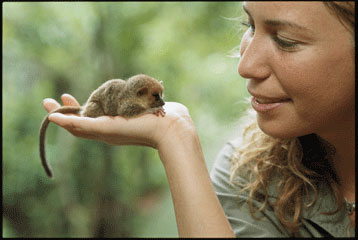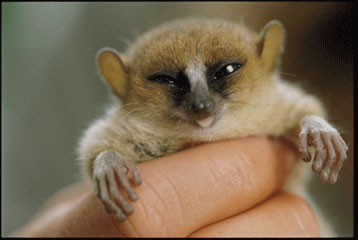3 new lemurs named in Madagascar
3 new lemurs named in Madagascar
Conservation International
June 21, 2006
To recognize an internationally renowned primatologist and champion of Madagascar’s unique biodiversity, scientists who discovered three new species of mouse lemur on the island nation have named one in honor of Russell A. Mittermeier, the president of Conservation International.
Mittermeier, the longtime chair of the IUCN Primate Special Group, is an expert on Madagascar and its lemurs, the distinctive primates found nowhere else on Earth. He is the lead author of “Lemurs of Madagascar,” a comprehensive field guide on the country’s flagship species.
His efforts inspired researcher Mireya Mayor to shift her scientific focus to Madagascar, and she was part of the team that discovered the three new mouse lemurs that were officially named in a paper published in June by the International Journal of Primatology. One of the new species is named Microcebus mittermeieri, or Mittermeier’s Mouse Lemur.
The other two named in the paper are Microcebus jollyae (Jolly’s Mouse Lemur), for Alison Jolly, a pioneering lemur researcher from Princeton University, and Microcebus simmonsi (Simmons’ Mouse Lemur), for Dr. Lee Simmons, director of the Omaha Henry Doorly Zoo in Nebraska.

Mireya Mayor with a mouse lemur. Photo Credit: Mark Thiessen/National Geographic Society.
A newly described species of mouse lemur (Microcebus mittermeieri). Photo Credit: Mark Thiessen/National Geographic Society. New lemur species named after British comedian
|
Mayor’s first research grant came from Mittermeier, and the discoveries by Mayor, Dr. Edward Louis and their Malagasy team occurred shortly before Madagascar President Marc Ravalomanana declared his visionary conservation policy in 2003 to triple Madagascar’s protected areas — including vital lemur habitat.
“I consider it a great honor to have a primate species named after me, and, given my life-long interest in Madagascar, I am especially pleased that it is a lemur. Other scientific discoveries come and go, but a new species becomes a permanent part of the scientific record, and will be with us forever,” Mittermeier said. “I am also delighted that this species is found in one of the highest priority areas for conservation in Madagascar, and that its discovery provides yet another justification for protecting the important Anjanaharibe-Sud Reserve.”
Mayor, a Fulbright scholar, National Geographic correspondent and former Miami Dolphins cheerleader, went to Madagascar after reading an article in a magazine about Mittermeier and his work with lemurs. The lemur that now bears Mittermeier’s name was discovered by Mayor and her colleagues on an expedition to study another lemur, the Critically Endangered silky sifaka.
Mouse lemurs are the smallest primates in the world, and the newest discoveries join the family of primates that represent Madagascar internationally.
“Finding an entirely new species of lemur living in the wild in the 21st Century shows how little we know about our natural world, and how important it is to protect it,” Mayor said. “This tiny creature has become a huge ambassador for all things wild in Madagascar, and that is truly remarkable.”
Both Mittermeier and Mayor are attending the CI Global Symposium from June 20-24 in Antananarivo, the capital of Madagascar. More than 300 participants at the conference are examining how Africa’s unmatched biodiversity can help alleviate poverty and promote sustainable development to benefit hundreds of millions of people across the continent.
The CI Global Symposium
Speakers will include Madagascar President Marc Ravalomanana; Jeffrey D. Sachs, director of the U.N. Millennium Project; and environmental leaders from around the world. Participants will discuss ways that sustainable management of ecosystems can help reduce poverty and hunger in many African countries.
The symposium includes five plenary sessions addressing different aspects of “green economic development,” and demonstrating how struggling countries can become tomorrow’s providers of ecosystem goods and services like fresh air, clean water, food, medicines, energy, climate regulation, flood control, pollination, disease prevention, and other of nature’s benefits necessary for economic prosperity and human survival.
This article is a modified news release from CI.








